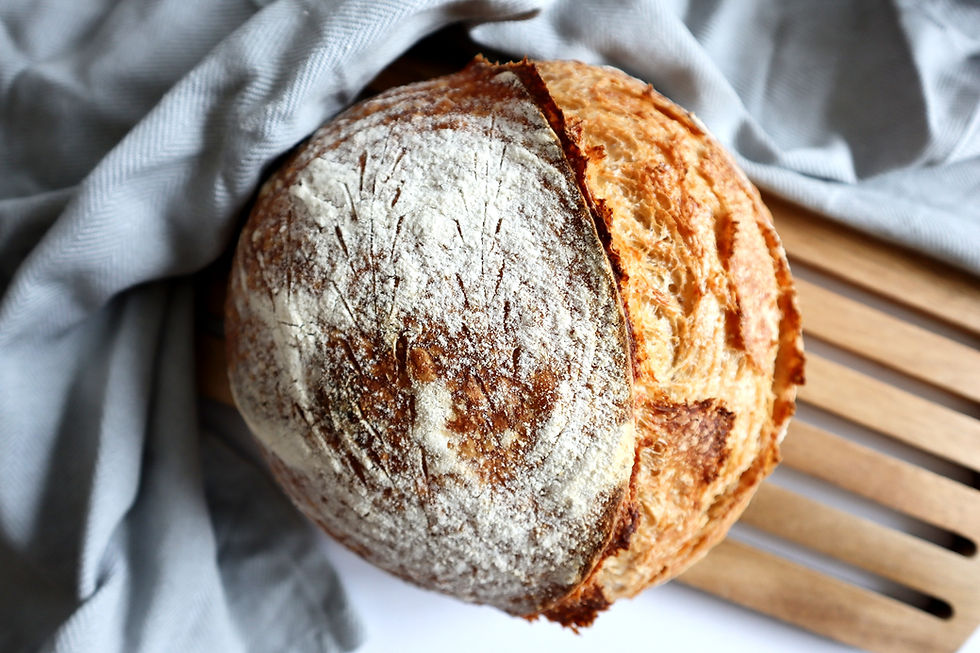#23 Sourdough - Manitoba, T65 & Whole Wheat
- Christean N.

- Feb 14, 2023
- 3 min read


Levain
60 g Water at 24°C
60 g Ripe Starter
30 g Whole Wheat Baker's Flour
30 g Organic White Baker's Flour
Final Dough
125 g White Baker's Flour (Manitoba) - 14.5% Protein
125 g T65 Baker's Flour
150 g Whole Wheat Baker's Flour
8 g Fine Salt
80 g Active Levain
320 g Water at 24°C
Schedule
5:30 am Refresh Levain (1:1:1) Ratio - Levain recipe above
Mix all the ingredients together and place into a jug with the lid loosely covered. Allow to ferment for 4 hours and up to 8 hours. This Levain at 24°C room temperature with 65% relative humidity will take approximately 4 to 5 hours until it triple in volume.
Note: If your naturally leavened does not seem to be having too much activity at the 4 hours mark, this will mean that the Levain is most likely too weak and will need several more feedings for a few more days before they can be used. It is best not to use weak Levain if you are tying to achieve the best leavened bread.
Alternatively, you can substitute some of the naturally Leavened with instant dry yeast.
10:30 am Autolyze
(5 hours later)
Mix all the flours with the water in to a mass. Cover and allow to autolyze for an hour. You should start to autolyze at least one hour prior to the Levain being estimated to be ready.
11:30 pm Add Levain to Autolyzed flour
(1 hour Later)
Add in the required Levain in to the autolyzed dough until well distributed. Cover and allow to rest for 30 minutes. The doughs should still feel shaggy and rough.
To test if the Levain is ready to use, it should already have doubled, if not tripled in volume. Gently scoop out a spoonful of Levain and drop it into a jug of water. If it floats atop, it is ready. If it sinks to the bottom, you will need for it to ferment for a little longer. Be mindful to scoop the Levain out gently. If you knocked out too much air during the process, the levain will sink under water regardless.
12 pm Add Salt
(30 minutes later)
Mix then cover and rest for 30 minutes
12:45 pm #1 Stretch & Fold
(30 minutes later)
Perform the first stretch and fold. Cover and rest for 30 minutes
1:15 pm #2 Stretch & Fold
(30 minutes later)
Perform the second stretch and fold. Cover and rest for 30 minutes.
1:45pm #3 Stretch & Fold
(30 minutes Later)
Perform the third stretch and fold. Cover and rest for 30 minutes.
2:15 pm #4 Stretch & Fold
(30 minutes later)
Perform the second stretch and fold. Cover and rest for 30 minutes.
2:45 pm #5 Stretch & Fold
(30 minutes later)
Perform the fifth stretch and fold. Cover and rest for 30 minutes.
3:15 pm #6 Stretch & Fold
(30 minutes later)
Perform the sixth and last stretch and fold. Cover and let the dough bulk ferment for the remaining 2 hours at room temperature.
5:15 pm Final Shaping
(2 hours later)
Final shape the boule and place it seam side up in to a well dusted banneton. Dust with some flour over the seams then place a plastic over. Leave at room temperature for another hour.
6 pm Retard
Place the sourdough into the fridge to retard and leave overnight for baking in the next morning.
The next day....
6 am Pre heating
(12 hours later...)
Place the cast iron pot with its lid into the oven and preheat with the oven at 220°C for an hour.
7 am Score and baking
Remove the sourdough from the fridge and carefully tilt over onto the cast iron pot. Dust with some baker's flour (optional) and score. Place the lid over with a slight opening. Spray generously with some water in the opening to create instant steam then close the lid tight.
Bake in the pre heated oven for 20 minutes, then remove the lid and continue to bake for a further 30 minutes to 40 minutes until the desired crust colour is achieved.
Once baked, remove the sourdough from the cast iron and allow to cool fully on to a wire rack without any baking paper at the base to prevent it from sweating.
Allow to cool for at least 2 hours before cutting.




Comments